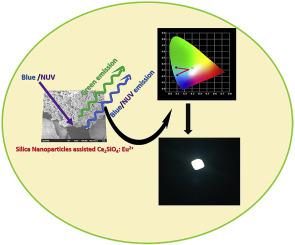Our official English website, www.x-mol.net, welcomes your feedback! (Note: you will need to create a separate account there.)
Development of bluish green-emitting Ca2-xEuxSiO4 phosphor: A novel approach using silica nanoparticles as precursor
Journal of Luminescence ( IF 3.6 ) Pub Date : 2021-02-01 , DOI: 10.1016/j.jlumin.2020.117664 Abinaya Mayavan , Jay Siva Ganesamurthi , Kiwan Jang , Sakthivel Gandhi
Journal of Luminescence ( IF 3.6 ) Pub Date : 2021-02-01 , DOI: 10.1016/j.jlumin.2020.117664 Abinaya Mayavan , Jay Siva Ganesamurthi , Kiwan Jang , Sakthivel Gandhi

|
Abstract Development of inorganic phosphors architecture is of immense concern for the growth of solid-state lighting technology. The current work focuses on the development of bluish green-emitting, silica nanoparticles assisted Ca2SiO4: Eu2+phosphors that are made via a two-step high-temperature wet-solid phase reaction technique. The optimized Eu2+ doping concentration in both the silica nanoparticles assisted Ca2SiO4: Eu2+and conventional silica assisted Ca2SiO4: Eu2+ has been calculated and found to be 5 mol%. Systematic studies viz morphology, crystal phase and photoluminescence were carried out on all the phosphor materials and their efficiencies were compared. The emission spectrum recorded at RT (Room Temperature) of the phosphor showed two prominent emission band centred at 490 and 525 nm under the excitation of 335 nm. The impregnation of silica nanoparticles in phosphors with the tailorable emissive properties has been extensively studied for their potential application in white LEDs. Finally, a prototype model of white LEDs has been fabricated using the optimized silica nanoparticle as well as conventional silica assisted Ca2SiO4: Eu2+ phosphors and their efficiencies were studied. The CIE coordinates, correlated colour temperature (CCT) and colour rendering index (CRI) were also calculated from the emission spectra of the fabricated proto-type white LED.
中文翻译:

蓝绿色发光 Ca2-xEuxSiO4 荧光粉的开发:一种使用二氧化硅纳米粒子作为前驱体的新方法
摘要 无机磷光体结构的发展对固态照明技术的发展至关重要。目前的工作重点是开发通过两步高温湿固相反应技术制备的蓝绿色发光二氧化硅纳米粒子辅助 Ca2SiO4:Eu2+ 荧光粉。经计算,二氧化硅纳米粒子辅助 Ca2SiO4:Eu2+ 和传统二氧化硅辅助 Ca2SiO4:Eu2+ 中优化的 Eu2+ 掺杂浓度为 5 mol%。对所有磷光体材料进行了形态、晶相和光致发光的系统研究,并比较了它们的效率。在 RT(室温)下记录的磷光体发射光谱显示在 335 nm 激发下以 490 和 525 nm 为中心的两个突出发射带。二氧化硅纳米粒子在具有可定制发射特性的磷光体中的浸渍已被广泛研究,因为它们在白光 LED 中的潜在应用。最后,使用优化的二氧化硅纳米颗粒以及传统的二氧化硅辅助 Ca2SiO4:Eu2+ 荧光粉制造了白光 LED 的原型模型,并研究了它们的效率。CIE 坐标、相关色温 (CCT) 和显色指数 (CRI) 也从制造的原型白光 LED 的发射光谱计算。研究了 Eu2+ 磷光体及其效率。CIE 坐标、相关色温 (CCT) 和显色指数 (CRI) 也从制造的原型白光 LED 的发射光谱计算。研究了 Eu2+ 磷光体及其效率。CIE 坐标、相关色温 (CCT) 和显色指数 (CRI) 也从制造的原型白光 LED 的发射光谱计算。
更新日期:2021-02-01
中文翻译:

蓝绿色发光 Ca2-xEuxSiO4 荧光粉的开发:一种使用二氧化硅纳米粒子作为前驱体的新方法
摘要 无机磷光体结构的发展对固态照明技术的发展至关重要。目前的工作重点是开发通过两步高温湿固相反应技术制备的蓝绿色发光二氧化硅纳米粒子辅助 Ca2SiO4:Eu2+ 荧光粉。经计算,二氧化硅纳米粒子辅助 Ca2SiO4:Eu2+ 和传统二氧化硅辅助 Ca2SiO4:Eu2+ 中优化的 Eu2+ 掺杂浓度为 5 mol%。对所有磷光体材料进行了形态、晶相和光致发光的系统研究,并比较了它们的效率。在 RT(室温)下记录的磷光体发射光谱显示在 335 nm 激发下以 490 和 525 nm 为中心的两个突出发射带。二氧化硅纳米粒子在具有可定制发射特性的磷光体中的浸渍已被广泛研究,因为它们在白光 LED 中的潜在应用。最后,使用优化的二氧化硅纳米颗粒以及传统的二氧化硅辅助 Ca2SiO4:Eu2+ 荧光粉制造了白光 LED 的原型模型,并研究了它们的效率。CIE 坐标、相关色温 (CCT) 和显色指数 (CRI) 也从制造的原型白光 LED 的发射光谱计算。研究了 Eu2+ 磷光体及其效率。CIE 坐标、相关色温 (CCT) 和显色指数 (CRI) 也从制造的原型白光 LED 的发射光谱计算。研究了 Eu2+ 磷光体及其效率。CIE 坐标、相关色温 (CCT) 和显色指数 (CRI) 也从制造的原型白光 LED 的发射光谱计算。



























 京公网安备 11010802027423号
京公网安备 11010802027423号